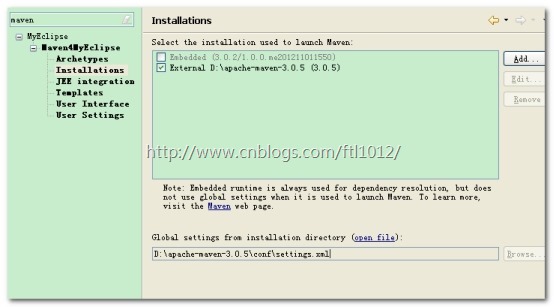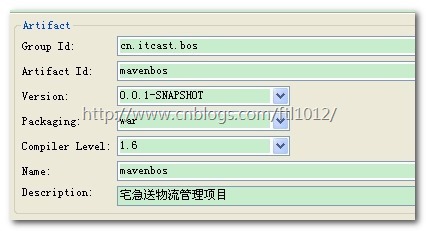Maven学习---使用maven进行项目构建
1. 使用maven进行项目构建
MyEclipse 自带maven 插件
Eclipse 需要单独安装maven插件
1.1. Maven 在企业中怎么用的 ?
Maven : 项目构建工具 ,进行项目编译、测试、打包、运行、发布 ….
使用 maven将工程进行组件化 ,项目分为 表现层、业务层、 数据层 属于maven创建 三个项目 ,分别进行三层开发
Maven 和 Jenkins (hudson) 对项目进行持续集成
企业中搭建私服
1.2. 建立maven骨架的项目,运行bos
1、 下载和解压 maven 的zip包
链接:https://pan.baidu.com/s/1Qt7alAjiHA0SsXlFuRpxrg 密码:kyan
2、 在myeclipse 配置外部 maven

3、 配置仓库setting文件 和 仓库位置
默认位置 C:\Users\Administrator\.m2 (这个文件夹没有 settings,xml )
将解压maven目录下的settings.xml 复制C:\Users\Administrator\.m2\settings.xml
<?xml version="1.0" encoding="UTF-8"?> <!--
Licensed to the Apache Software Foundation (ASF) under one
or more contributor license agreements. See the NOTICE file
distributed with this work for additional information
regarding copyright ownership. The ASF licenses this file
to you under the Apache License, Version 2.0 (the
"License"); you may not use this file except in compliance
with the License. You may obtain a copy of the License at http://www.apache.org/licenses/LICENSE-2.0 Unless required by applicable law or agreed to in writing,
software distributed under the License is distributed on an
"AS IS" BASIS, WITHOUT WARRANTIES OR CONDITIONS OF ANY
KIND, either express or implied. See the License for the
specific language governing permissions and limitations
under the License.
--> <!--
| This is the configuration file for Maven. It can be specified at two levels:
|
| 1. User Level. This settings.xml file provides configuration for a single user,
| and is normally provided in ${user.home}/.m2/settings.xml.
|
| NOTE: This location can be overridden with the CLI option:
|
| -s /path/to/user/settings.xml
|
| 2. Global Level. This settings.xml file provides configuration for all Maven
| users on a machine (assuming they're all using the same Maven
| installation). It's normally provided in
| ${maven.home}/conf/settings.xml.
|
| NOTE: This location can be overridden with the CLI option:
|
| -gs /path/to/global/settings.xml
|
| The sections in this sample file are intended to give you a running start at
| getting the most out of your Maven installation. Where appropriate, the default
| values (values used when the setting is not specified) are provided.
|
|-->
<settings xmlns="http://maven.apache.org/SETTINGS/1.0.0"
xmlns:xsi="http://www.w3.org/2001/XMLSchema-instance"
xsi:schemaLocation="http://maven.apache.org/SETTINGS/1.0.0 http://maven.apache.org/xsd/settings-1.0.0.xsd">
<!-- localRepository
| The path to the local repository maven will use to store artifacts.
|
| Default: ~/.m2/repository
<localRepository>/path/to/local/repo</localRepository>
--> <!-- interactiveMode
| This will determine whether maven prompts you when it needs input. If set to false,
| maven will use a sensible default value, perhaps based on some other setting, for
| the parameter in question.
|
| Default: true
<interactiveMode>true</interactiveMode>
--> <!-- offline
| Determines whether maven should attempt to connect to the network when executing a build.
| This will have an effect on artifact downloads, artifact deployment, and others.
|
| Default: false
<offline>false</offline>
--> <!-- pluginGroups
| This is a list of additional group identifiers that will be searched when resolving plugins by their prefix, i.e.
| when invoking a command line like "mvn prefix:goal". Maven will automatically add the group identifiers
| "org.apache.maven.plugins" and "org.codehaus.mojo" if these are not already contained in the list.
|-->
<pluginGroups>
<!-- pluginGroup
| Specifies a further group identifier to use for plugin lookup.
<pluginGroup>com.your.plugins</pluginGroup>
-->
</pluginGroups> <!-- proxies
| This is a list of proxies which can be used on this machine to connect to the network.
| Unless otherwise specified (by system property or command-line switch), the first proxy
| specification in this list marked as active will be used.
|-->
<proxies>
<!-- proxy
| Specification for one proxy, to be used in connecting to the network.
|
<proxy>
<id>optional</id>
<active>true</active>
<protocol>http</protocol>
<username>proxyuser</username>
<password>proxypass</password>
<host>proxy.host.net</host>
<port>80</port>
<nonProxyHosts>local.net|some.host.com</nonProxyHosts>
</proxy>
-->
</proxies> <!-- servers
| This is a list of authentication profiles, keyed by the server-id used within the system.
| Authentication profiles can be used whenever maven must make a connection to a remote server.
|-->
<servers>
<!-- server
| Specifies the authentication information to use when connecting to a particular server, identified by
| a unique name within the system (referred to by the 'id' attribute below).
|
| NOTE: You should either specify username/password OR privateKey/passphrase, since these pairings are
| used together.
|
-->
<server>
<id>myserver</id>
<username>tomcat</username>
<password>123456</password>
</server> <!-- Another sample, using keys to authenticate.
<server>
<id>siteServer</id>
<privateKey>/path/to/private/key</privateKey>
<passphrase>optional; leave empty if not used.</passphrase>
</server>
-->
</servers> <!-- mirrors
| This is a list of mirrors to be used in downloading artifacts from remote repositories.
|
| It works like this: a POM may declare a repository to use in resolving certain artifacts.
| However, this repository may have problems with heavy traffic at times, so people have mirrored
| it to several places.
|
| That repository definition will have a unique id, so we can create a mirror reference for that
| repository, to be used as an alternate download site. The mirror site will be the preferred
| server for that repository.
|-->
<mirrors>
<!-- mirror
| Specifies a repository mirror site to use instead of a given repository. The repository that
| this mirror serves has an ID that matches the mirrorOf element of this mirror. IDs are used
| for inheritance and direct lookup purposes, and must be unique across the set of mirrors.
|
<mirror>
<id>mirrorId</id>
<mirrorOf>repositoryId</mirrorOf>
<name>Human Readable Name for this Mirror.</name>
<url>http://my.repository.com/repo/path</url>
</mirror>
-->
</mirrors> <!-- profiles
| This is a list of profiles which can be activated in a variety of ways, and which can modify
| the build process. Profiles provided in the settings.xml are intended to provide local machine-
| specific paths and repository locations which allow the build to work in the local environment.
|
| For example, if you have an integration testing plugin - like cactus - that needs to know where
| your Tomcat instance is installed, you can provide a variable here such that the variable is
| dereferenced during the build process to configure the cactus plugin.
|
| As noted above, profiles can be activated in a variety of ways. One way - the activeProfiles
| section of this document (settings.xml) - will be discussed later. Another way essentially
| relies on the detection of a system property, either matching a particular value for the property,
| or merely testing its existence. Profiles can also be activated by JDK version prefix, where a
| value of '1.4' might activate a profile when the build is executed on a JDK version of '1.4.2_07'.
| Finally, the list of active profiles can be specified directly from the command line.
|
| NOTE: For profiles defined in the settings.xml, you are restricted to specifying only artifact
| repositories, plugin repositories, and free-form properties to be used as configuration
| variables for plugins in the POM.
|
|-->
<profiles>
<!-- profile
| Specifies a set of introductions to the build process, to be activated using one or more of the
| mechanisms described above. For inheritance purposes, and to activate profiles via <activatedProfiles/>
| or the command line, profiles have to have an ID that is unique.
|
| An encouraged best practice for profile identification is to use a consistent naming convention
| for profiles, such as 'env-dev', 'env-test', 'env-production', 'user-jdcasey', 'user-brett', etc.
| This will make it more intuitive to understand what the set of introduced profiles is attempting
| to accomplish, particularly when you only have a list of profile id's for debug.
|
| This profile example uses the JDK version to trigger activation, and provides a JDK-specific repo.
<profile>
<id>jdk-1.4</id> <activation>
<jdk>1.4</jdk>
</activation> <repositories>
<repository>
<id>jdk14</id>
<name>Repository for JDK 1.4 builds</name>
<url>http://www.myhost.com/maven/jdk14</url>
<layout>default</layout>
<snapshotPolicy>always</snapshotPolicy>
</repository>
</repositories>
</profile>
--> <!--
| Here is another profile, activated by the system property 'target-env' with a value of 'dev',
| which provides a specific path to the Tomcat instance. To use this, your plugin configuration
| might hypothetically look like:
|
| ...
| <plugin>
| <groupId>org.myco.myplugins</groupId>
| <artifactId>myplugin</artifactId>
|
| <configuration>
| <tomcatLocation>${tomcatPath}</tomcatLocation>
| </configuration>
| </plugin>
| ...
|
| NOTE: If you just wanted to inject this configuration whenever someone set 'target-env' to
| anything, you could just leave off the <value/> inside the activation-property.
|
<profile>
<id>env-dev</id> <activation>
<property>
<name>target-env</name>
<value>dev</value>
</property>
</activation> <properties>
<tomcatPath>/path/to/tomcat/instance</tomcatPath>
</properties>
</profile>
-->
</profiles> <!-- activeProfiles
| List of profiles that are active for all builds.
|
<activeProfiles>
<activeProfile>alwaysActiveProfile</activeProfile>
<activeProfile>anotherAlwaysActiveProfile</activeProfile>
</activeProfiles>
-->
</settings>
settings.xml

在 settings.xml 指定本地仓库位置

Maven 原理: 使用坐标导入jar包,先在本地仓库找,如果没有,会去网络上仓库下载 !
4、 将 repository.rar 解压,覆盖本机原来 的仓库
5、 在myeclipse 建立maven工程
可以自己选择骨架

quickstart 骨架, javase的maven项目
webapp 骨架, javaee的maven项目
² 使用simple project 骨架

输入maven参数
坐标 : GroupId 、ArtifactId 、Version
Packing 打包方式 : jar(给别人引入的)、pom(给别人继承的)、war (用来运行的)

maven 项目结构分析
src/main/java 存放项目源码
src/main/resources 存放项目配置文件
src/test/java 存放测试用例代码
src/test/resources 存放测试配置文件
src/main/webapp 文件夹用来存放页面代码
6、 移植项目
将源码 src/main/java
将配置文件 src/main/resources
将页面 src/main/webapp (WEB-INF 不要移动lib,只需要pages和web.xml )
7、 编写pom.xml
使用坐标导入 jar包

只需要获取 需要项目坐标,就可以引入
http://search.maven.org/
http://mvnrepository.com/
附参考pom.xml
<project xmlns="http://maven.apache.org/POM/4.0.0" xmlns:xsi="http://www.w3.org/2001/XMLSchema-instance"
xsi:schemaLocation="http://maven.apache.org/POM/4.0.0 http://maven.apache.org/xsd/maven-4.0.0.xsd">
<modelVersion>4.0.0</modelVersion>
<groupId>com.hauwei.bos</groupId>
<artifactId>mavenbos</artifactId>
<version>0.0.1-SNAPSHOT</version>
<packaging>war</packaging>
<name>mavenbox</name>
<description>XXXX管理项目</description>
<dependencies>
<!-- spring 3.2 -->
<dependency>
<groupId>org.springframework</groupId>
<artifactId>spring-context</artifactId>
<version>3.2.0.RELEASE</version>
</dependency>
<dependency>
<groupId>org.springframework</groupId>
<artifactId>spring-orm</artifactId>
<version>3.2.0.RELEASE</version>
</dependency>
<dependency>
<groupId>org.springframework</groupId>
<artifactId>spring-aspects</artifactId>
<version>3.2.0.RELEASE</version>
</dependency>
<dependency>
<groupId>org.springframework</groupId>
<artifactId>spring-web</artifactId>
<version>3.2.0.RELEASE</version>
</dependency>
<dependency>
<groupId>org.springframework</groupId>
<artifactId>spring-test</artifactId>
<version>3.2.0.RELEASE</version>
</dependency>
<!-- Struts 2 -->
<dependency>
<groupId>org.apache.struts</groupId>
<artifactId>struts2-core</artifactId>
<version>2.3.7</version>
</dependency>
<dependency>
<groupId>org.apache.struts</groupId>
<artifactId>struts2-json-plugin</artifactId>
<version>2.3.7</version>
</dependency>
<dependency>
<groupId>org.apache.struts</groupId>
<artifactId>struts2-spring-plugin</artifactId>
<version>2.3.7</version>
</dependency>
<!-- hibernate 3.6 -->
<dependency>
<groupId>org.hibernate</groupId>
<artifactId>hibernate-core</artifactId>
<version>3.6.10.Final</version>
</dependency>
<!-- JPA -->
<dependency>
<groupId>org.hibernate.javax.persistence</groupId>
<artifactId>hibernate-jpa-2.0-api</artifactId>
<version>1.0.1.Final</version>
</dependency>
<!-- Servlet & Jsp -->
<dependency>
<groupId>javax.servlet</groupId>
<artifactId>servlet-api</artifactId>
<version>2.5</version>
<scope>provided</scope> <!-- 只在编译和测试环境下使用,不参与打包运行,默认值Runtime -->
</dependency>
<dependency>
<groupId>javax.servlet</groupId>
<artifactId>jsp-api</artifactId>
<version>2.0</version>
<scope>provided</scope>
</dependency>
<!-- log4j -->
<dependency>
<groupId>org.slf4j</groupId>
<artifactId>slf4j-log4j12</artifactId>
<version>1.7.2</version>
</dependency>
<dependency>
<groupId>log4j</groupId>
<artifactId>log4j</artifactId>
<version>1.2.16</version>
</dependency>
<!-- C3P0 -->
<dependency>
<groupId>c3p0</groupId>
<artifactId>c3p0</artifactId>
<version>0.9.1.2</version>
</dependency>
<!-- mysql -->
<dependency>
<groupId>mysql</groupId>
<artifactId>mysql-connector-java</artifactId>
<version>5.1.6</version>
</dependency>
<!-- junit -->
<dependency>
<groupId>junit</groupId>
<artifactId>junit</artifactId>
<version>4.9</version>
<scope>test</scope>
</dependency>
<!-- poi -->
<dependency>
<groupId>org.apache.poi</groupId>
<artifactId>poi</artifactId>
<version>3.9</version>
</dependency>
<!-- 配置pinyin4j -->
<dependency>
<groupId>com.belerweb</groupId>
<artifactId>pinyin4j</artifactId>
<version>2.5.0</version>
</dependency>
<!-- 配置Hessian -->
<dependency>
<groupId>com.caucho</groupId>
<artifactId>hessian</artifactId>
<version>4.0.33</version>
</dependency> <!-- 配置Hessian-Search -->
<dependency>
<groupId>org.hibernate</groupId>
<artifactId>hibernate-search</artifactId>
<version>3.4.2.Final</version>
</dependency>
<!-- IK -->
<dependency>
<groupId>org.wltea</groupId>
<artifactId>IKAnalyzer</artifactId>
<version>2012_u6</version>
<scope>system</scope>
<systemPath>F:\ftl\mavenbox_day02\src\main\webapp\WEB-INF\lib\IKAnalyzer2012_u6.jar</systemPath>
</dependency> </dependencies>
<build>
<finalName>mavenbos</finalName>
<plugins>
<plugin>
<artifactId>maven-compiler-plugin</artifactId>
<configuration>
<source>1.6</source>
<target>1.6</target>
</configuration>
</plugin>
<plugin>
<groupId>org.apache.tomcat.maven</groupId>
<artifactId>tomcat7-maven-plugin</artifactId>
<version>2.1</version>
</plugin>
</plugins>
</build>
</project>
pom.xml
8、运行项目
右键项目 – run as --- maven build ---- tomcat:run

使用 maven tomcat plugin 1.1 进行运行
3.3. tomcat-maven-plugin 插件
早期插件 groupId : org.codehaus.mojo , artifactId : tomcat-maven-plugin 版本1.1

现在这个插件,被分为两个插件,坐标也改了


附文件:
<!-- tomcat plugin 分为tomcat6 和 tomcat7 两个插件 -->
<!-- http://mojo.codehaus.org/tomcat-maven-plugin/index.html -->
<plugin>
<groupId>org.apache.tomcat.maven</groupId>
<artifactId>tomcat7-maven-plugin</artifactId>
<version>2.1</version>
</plugin>
<plugin>
<groupId>org.apache.tomcat.maven</groupId>
<artifactId>tomcat6-maven-plugin</artifactId>
<version>2.1</version>
</plugin> <!-- 早期tomcat maven plugin 使用 -->
<plugin>
<groupId>org.codehaus.mojo</groupId>
<artifactId>tomcat-maven-plugin</artifactId>
<version>1.1</version>
<configuration>
<!-- tomcat6.x -->
<url>http://localhost:8080/manager</url>
<!-- tomcat7.x -->
<!-- <url>http://localhost:8080/manager/text</url> -->
<server>myserver</server>
</configuration>
</plugin> 远程访问 tomcat6 : tomcat-users.xml
<role rolename="manager"/>
<user username="tomcat" password="123456" roles="manager"/> 远程访问 tomcat7 : tomcat-users.xml
<role rolename="manager-gui"/>
<role rolename="manager-script"/>
<user username="tomcat" password="123456" roles="manager-gui, manager-script"/>
maven tomcat plugin
3.3.1. 修改内部运行 tomcat的端口
<!-- 对插件进行配置 -->
<configuration>
<port>80</port>
</configuration>
最新文章
- python之路:Day03 --- Python基础3 >>函数
- timus_1007_代码字
- 驳 GarbageMan 的《一个超复杂的简介递归》——对延迟计算的实验和思考
- 12232 - Exclusive-OR
- MySQL查询当前数据上一条和下一条的记录
- css画下图
- Hibernate框架进阶(下篇)之查询
- 使用 Moq 测试.NET Core 应用 -- Mock 属性
- Flutter路由导航Navigator
- TensorFlow资源整理
- NLP入门(三)词形还原(Lemmatization)
- ELK部署详解--kibana
- vim格式化markdown表格
- Bootstrap关闭当前页
- POJ 3421 X-factor Chains (因式分解+排列组合)
- 2015.4.21第一篇cnblog文章
- iOS 下 Podfile 使用方法
- linux中执行java或者mvn命令提示没有权限解决办法
- 如何处理加括号的四则混合运算表达式——基于二叉树的实现(Eclipse平台 Java版)
- NumPy-快速处理数据--ufunc运算--广播--ufunc方法